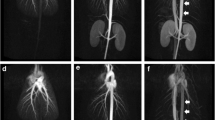Abstract
The purpose of this study was to investigate the influence of different injection rates on the maximum signal intensity and the arterio-venous transit time of dynamic gadofosveset-enhanced first pass MR angiography (MRA). Twenty-one healthy male volunteers were examined with a time-resolved echo-shared MRA at 1.5 T. The volunteers were assigned into three groups using injection rates of either 1, 2 or 4 ml/s. The maximal signal enhancement and peak signal-to-noise ratio in the pulmonary trunk, the aortic arch, the abdominal aorta as well as both kidneys and lung parenchyma were analyzed. The arterio-venous transit time was determined. The time between maximal enhancement of the pulmonary trunk and the aortic arch was higher with the slow injection rate of 1 ml/s, while there were no differences in the time between maximal enhancement of the aortic arch and the abdominal aorta above or below the origin of the renal veins with all three injection rates. With the slow injection protocol of 1 ml/s a longer purely arterial phase of 10.5 s was achieved compared to 7.7 s with higher injection rates (p = 0.045). The time between maximal aortic signal intensity and maximal renal enhancement was equal for all injection protocols.


Similar content being viewed by others
References
Lauffer RB, Parmelee DJ, Dunham SU et al (1998) MS-325: albumin-targeted contrast agent for MR angiography. Radiology 207:529–538
Rohrer M (2005) Comparison of magnetic properties of MRI contrast media solutions at different magnetic field strengths. Invest Radiol 40:715–724
Caravan P, Parigi G, Chasse JM et al (2007) Albumin binding, relaxivity, and water exchange kinetics of the diastereoisomers of MS-325, a gadolinium(III)-based magnetic resonance angiography contrast agent. Inorg Chem 46:6632–6639
Klessen C, Hein PA, Huppertz A et al (2007) First-pass whole-body magnetic resonance angiography (mra) using the blood-pool contrast medium gadofosveset trisodium: comparison to gadopentetate dimeglumine. Invest Radiol 42:659–664
Hartmann M, Wiethoff AJ, Hentrich HR, Rohrer M (2006) Initial imaging recommendations for Vasovist angiography. Eur Radiol 16(Suppl 2):B15–B23
Grist TM, Korosec FR, Peters DC et al (1998) Steady-state and dynamic MR angiography with MS-325: initial experience in humans. Radiology 207:539–544
Hartmann M (2006) Initial imaging recommendations for Vasovist angiography. Eur Radiol 16(Suppl 2):B15–B23
Rohrer M, Bauer H, Mintorovitch J, Requardt M, Weinmann HJ (2005) Comparison of magnetic properties of MRI contrast media solutions at different magnetic field strengths. Invest Radiol 40:715–724
Caravan P, Cloutier NJ, Greenfield MT et al (2002) The interaction of MS-325 with human serum albumin and its effect on proton relaxation rates. J Am Chem Soc 124:3152–3162
Eldredge HB, Spiller M, Chasse JM, Greenwood MT, Caravan P (2006) Species dependence on plasma protein binding and relaxivity of the gadolinium-based MRI contrast agent MS-325. Invest Radiol 41:229–243
Griswold MA, Jakob PM, Heidemann RM et al (2002) Generalized autocalibrating partially parallel acquisitions (GRAPPA). Magn Reson Med 47:1202–1210
Korosec FR, Frayne R, Grist TM, Mistretta CA (1996) Time-resolved contrast-enhanced 3D MR angiography. Magn Reson Med 36:345–351
Fink C, Ley S, Kroeker R et al (2005) Time-resolved contrast-enhanced three-dimensional magnetic resonance angiography of the chest: combination of parallel imaging with view sharing (TREAT). Invest Radiol 40:40–48
Dietrich O, Raya JG, Reeder SB, Reiser MF, Schoenberg SO (2007) Measurement of signal-to-noise ratios in MR images: Influence of multichannel coils, parallel imaging, and reconstruction filters. J Magn Reson Imaging 26:375–385
Fink C, Puderbach M, Ley S et al (2004) Contrast-enhanced three-dimensional pulmonary perfusion magnetic resonance imaging: intraindividual comparison of 1.0 M gadobutrol and 0.5 M Gd-DTPA at three dose levels. Invest Radiol 39:143–148
Johnson TR, Nikolaou K, Wintersperger BJ et al (2007) Optimization of contrast material administration for electrocardiogram-gated computed tomographic angiography of the chest. J Comput Assist Tomogr 31:265–271
Author information
Authors and Affiliations
Corresponding author
Additional information
Johanna C. Nissen and Ulrike I. Attenberger contributed equally.
Rights and permissions
About this article
Cite this article
Nissen, J.C., Attenberger, U.I., Fink, C. et al. Thoracic and abdominal MRA with gadofosveset: Influence of injection rate on vessel signal and image quality. Eur Radiol 19, 1932–1938 (2009). https://doi.org/10.1007/s00330-009-1381-y
Received:
Revised:
Accepted:
Published:
Issue Date:
DOI: https://doi.org/10.1007/s00330-009-1381-y




